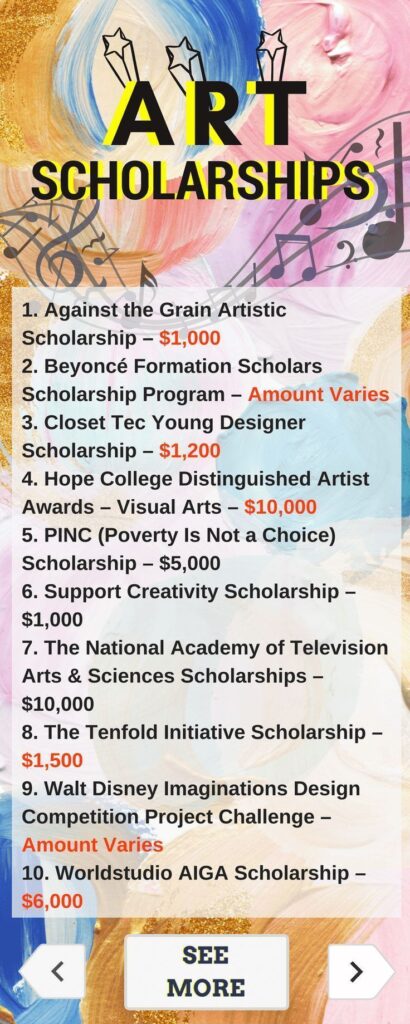I remember staring at the glossy brochures of art schools, my heart thrumming with a mix of wild excitement and a cold dread. Each page showcased vibrant studios, passionate students, and incredible artworks – a future I desperately wanted to be a part of. But then I’d flip to the tuition page, and that cold dread would settle deep in my stomach. The numbers felt like an impossible wall, blocking my path to a dream that felt as vital as breathing. My family, though incredibly supportive of my artistic aspirations, simply didn’t have the kind of money these institutions demanded. "How will I ever get there?" I’d whisper to myself, tracing the lines of a charcoal sketch in my worn-out notebook.
This isn’t just my story; it’s the story of countless aspiring artists. We’re often told that following an artistic path is noble but financially precarious. And while it’s true that art school comes with a hefty price tag, what many don’t realize is that there are pathways, hidden doors, and guiding lights in the form of scholarships. I learned this the hard way, through a lot of searching, a few tears, and a whole lot of creative problem-solving. And today, I want to share that journey with you, hoping to light a similar path for your own artistic adventure.
The Big Secret: Scholarships Exist, And They’re Waiting for You
Before I started my own quest, I thought scholarships were only for the straight-A valedictorians or athletic superstars. I imagined dusty old professors in tweed jackets sifting through piles of perfect academic records, looking for the next Nobel laureate. But what I discovered was a vibrant, diverse world of financial aid specifically designed for artists – for painters, sculptors, designers, animators, photographers, and every creative soul in between. These aren’t just handouts; they’re investments in your potential, a recognition of your talent, and a belief in the power of your unique vision.
The first step, and perhaps the most important, is to shed any preconceived notions. Don’t assume you’re not "good enough" or that your art isn’t "fine art" enough. Every artistic discipline, every unique style, has a place. The key is to find the scholarships that align with who you are and what you create.
Where to Begin Your Hunt: Casting a Wide Net
Think of your scholarship search like a treasure hunt. You need a map, some tools, and a good dose of persistence. My initial approach was scattered, a bit like throwing spaghetti at the wall to see what stuck. But I quickly learned that a more organized strategy was crucial.
-
Start with the Schools Themselves: Every art school worth its salt offers scholarships. These are often the most generous and directly tied to your acceptance. They usually fall into a few categories:
- Merit-Based Scholarships: These are awarded based on your artistic talent, as showcased in your portfolio, and sometimes your academic record. The school wants you, and they’re willing to help make it happen.
- Need-Based Scholarships: These consider your family’s financial situation. You’ll typically need to fill out federal forms like the FAFSA (Free Application for Federal Student Aid) to demonstrate your financial need.
- Department-Specific Scholarships: Some schools have scholarships tied to particular departments – a "Painting Excellence Scholarship" or a "Graphic Design Innovator Award." Dig deep into each school’s financial aid page.
-
Look Beyond the School Walls: External Scholarships: This is where the real digging begins. There are thousands of organizations, foundations, community groups, and even individuals who offer scholarships.
- National Art Organizations: Groups like the Scholastic Art & Writing Awards (a huge one for high schoolers!), the National YoungArts Foundation, or regional art councils often have scholarship programs.
- Community Foundations: Don’t overlook your local community. Many towns have foundations that offer scholarships specifically for local students pursuing higher education, often without a strong emphasis on a particular major.
- Niche Scholarships: Are you left-handed? Do you have a specific heritage? Are you interested in a particular art form like printmaking or textile design? There are scholarships for almost anything! Use scholarship search engines (like Fastweb, Scholarship.com, or College Board) and filter by your interests.
- Corporate Sponsorships: Sometimes, companies with an interest in design or creativity will offer scholarships. Think about companies that use a lot of visual branding or rely on creative talent.
My advice? Create a spreadsheet. List the scholarship name, the amount, the requirements, the deadline, and a link to the application. This will keep you sane when you’re juggling multiple applications.
Your Artistic Voice: The Portfolio (The Heart of It All)
For an aspiring artist, your portfolio isn’t just a collection of pretty pictures; it’s your visual voice, your artistic heartbeat, and often, the most critical component of your scholarship application. This is where you truly shine, showing the admissions committee who you are as a creator. I spent months agonizing over my portfolio, selecting pieces, getting feedback, and even creating new work specifically for it.
What makes a strong portfolio?
- Originality and Authenticity: Scholarship committees aren’t looking for perfect copies of famous artworks. They want to see your perspective, your unique way of seeing the world. Don’t be afraid to show vulnerability, experiment, and let your personality bleed onto the canvas (or screen, or clay).
- Skill and Craftsmanship: While originality is key, a solid foundation in technique is also important. Show that you understand composition, color theory, anatomy (if applicable), perspective, and how to use your chosen mediums effectively. Your pieces don’t have to be hyper-realistic, but they should demonstrate intentionality and control.
- Storytelling and Narrative: Can your art tell a story? Does it evoke emotion? Does it make the viewer think? Even abstract pieces can convey a mood or concept. Think about the message you want to send with each piece.
- Variety (with a focus): Include a range of mediums (drawing, painting, sculpture, digital art, photography, mixed media) to showcase your versatility. However, also include a few pieces that highlight your strongest area. If you’re a painter, make sure your best paintings are front and center. I made sure to include observational drawings, a few expressive paintings, and a couple of conceptual pieces that showed my thought process.
- Process Work (Sometimes): Some schools appreciate seeing sketchbook pages, preliminary sketches, or pieces that show how an idea evolved. This gives them insight into your creative process, not just the finished product.
- Quality over Quantity: It’s better to have 10-15 outstanding pieces than 20 mediocre ones. Every piece should pull its weight. If you’re unsure about a piece, get honest feedback from a trusted art teacher or mentor.
- Presentation Matters: If you’re submitting digitally, ensure your photographs are clear, well-lit, and accurately represent your work. Label each piece with its title, medium, dimensions, and date. If it’s a physical portfolio, make sure it’s clean, organized, and easy to navigate.
My art teacher was invaluable during this stage. She helped me cull pieces, suggested improvements, and taught me how to photograph my work professionally. Don’t try to do this alone. Seek out mentors, teachers, or even experienced peers who can offer constructive criticism.
Telling Your Story: The Scholarship Essay
If your portfolio shows what you can do, your scholarship essay tells why you do it. This is your chance to speak directly to the committee, to articulate your passion, your struggles, and your aspirations. Many scholarships require an essay, and some even ask for a specific artist statement about your work.
Here’s what I learned about writing a compelling essay:
- Be Authentic: Don’t try to be someone you’re not. Write in your own voice. Share a personal anecdote that reveals your connection to art. For me, I wrote about a challenging period in my life and how art became my refuge and my voice.
- Show, Don’t Just Tell: Instead of saying "I am passionate about art," describe a moment when your passion was evident. "I remember losing track of time, the smell of turpentine filling my small room, as I worked tirelessly on a portrait, utterly absorbed in the dance of light and shadow."
- Address the Prompt Directly: Read the essay prompt carefully. If it asks about your artistic influences, talk about them. If it asks about a challenge you overcame, share that story. Don’t ramble.
- Connect Your Art to Your Life: How has art shaped you? What impact do you hope your art will have? What unique perspective do you bring to the artistic world?
- Proofread, Proofread, Proofread: A well-written essay demonstrates attention to detail and respect for the committee. Typos and grammatical errors can undermine your application. Have multiple people read it – friends, teachers, family.
Remember, the essay is about showing your character, your drive, and your potential, not just your ability to craft a sentence. It’s about making them feel your commitment.
The Advocates: Letters of Recommendation
Letters of recommendation are like character witnesses for your artistic journey. They provide an outside perspective on your abilities, work ethic, and potential. Most scholarships will ask for at least one, often two, letters.
- Who to Ask: Your art teacher is typically the best choice. They’ve seen your work firsthand, know your artistic growth, and can speak specifically about your talent. An academic teacher who knows you well and can speak to your diligence and critical thinking skills is also a great option. If you have an art mentor outside of school, they could also be a strong recommender.
- How to Ask: Ask politely and well in advance of the deadline. "Would you be willing to write a strong letter of recommendation for me for several art school scholarships?" is a good starting point. Be prepared for them to say no if they feel they can’t write a strong letter, and respect that.
- Provide Them with What They Need: Make it easy for your recommenders. Give them a packet with:
- A list of the scholarships you’re applying for, including deadlines and submission instructions.
- Your resume or a list of your artistic achievements and extracurricular activities.
- Your artist statement or a draft of your essay, so they understand your goals.
- A few bullet points reminding them of specific projects or qualities you’d like them to highlight.
- A polite thank-you note and a small gift (like a coffee shop gift card) after they submit the letters are always appreciated.
A heartfelt recommendation from someone who truly believes in you can significantly boost your application.
The Nitty-Gritty Details: Application Logistics
Once you have your portfolio, essay, and recommenders lined up, it’s all about meticulous organization.
- Deadlines Are Sacred: Mark every deadline on your calendar, and aim to submit a few days early. Technical glitches happen, and you don’t want to be scrambling at the last minute.
- Read Instructions Carefully: Every scholarship has specific requirements. One might ask for a video, another for specific dimensions for your images. Missing a small detail can disqualify you.
- Organize Your Documents: Keep all your essays, artist statements, transcripts, and recommendation requests in clearly labeled folders on your computer.
- Online Application Portals: Most applications are online now. Create accounts, save your progress frequently, and make sure all required fields are filled out.
- Follow Up (Politely): A week or two before the deadline, send a polite reminder to your recommenders if they haven’t confirmed submission.
This part isn’t glamorous, but it’s essential. Think of it as the scaffolding that supports your beautiful artistic creation.
Beyond the Main Application: Interviews and Auditions
Some scholarships, especially those tied to specific art programs, might require an interview or even an in-person audition. Don’t panic!
- Prepare to Talk About Your Art: Be ready to discuss your portfolio pieces – your inspiration, your process, what challenges you faced, and what you learned. Practice articulating your artistic vision.
- Be Yourself: Authenticity is key. Committees want to see your passion and personality.
- Ask Questions: This shows your engagement and genuine interest in the program or scholarship.
- Dress Appropriately: You don’t need a suit, but look neat and presentable.
My interview felt more like a conversation about art than an interrogation. I talked about my favorite artists, how I felt when I was creating, and what I hoped to achieve with my art. It was nerve-wracking, but ultimately, it solidified my belief in my path.
When Things Don’t Go to Plan (and they might)
Here’s the tough truth: you might not get every scholarship you apply for. I certainly didn’t. I received a handful of rejections, each one stinging a little. It’s easy to feel discouraged, to question your talent, or to think you’ll never achieve your dream. But this is where persistence and resilience become your most valuable tools.
- Rejection is Part of the Process: It’s not a reflection of your worth as an artist. There are countless factors at play – the sheer number of applicants, the specific criteria they were looking for, or simply bad timing.
- Learn from It: If possible, politely ask for feedback. Some committees might not provide it, but if they do, it can be invaluable for future applications.
- Don’t Give Up: Use the experience to refine your portfolio, strengthen your essays, and seek out new opportunities. My rejections spurred me to work harder, to make my next application even stronger.
- Explore Other Funding Options: If scholarships aren’t enough, consider grants (which don’t need to be repaid), federal student loans (which typically have lower interest rates and more flexible repayment plans than private loans), or even part-time work during school. Many art students work in galleries, studios, or even as freelance artists to supplement their income.
- Reapply: Some scholarships allow you to reapply in subsequent years. Your art will evolve, and your application will get stronger.
My Journey’s End (for now): A Path Paved with Persistence
After months of dedicated effort, the email finally arrived. It wasn’t the biggest scholarship, but combined with a few smaller awards and some institutional aid, it was enough. Enough to chip away at that intimidating tuition wall, enough to make my dream feel tangible, within reach. The relief and joy I felt were immense, a validation not just of my artistic talent, but of my perseverance.
Going through the scholarship application process taught me so much more than just how to fill out forms. It taught me how to articulate my artistic vision, how to critically assess my own work, how to seek and accept feedback, and most importantly, how to advocate for myself and my dreams. It was an education in itself, long before I even stepped foot in an art school studio.
A Final Word of Encouragement
If you’re an aspiring artist staring at those tuition numbers with a knot in your stomach, please know this: your dream is valid, and there are people and organizations out there who want to support it. The path to art school, especially when you’re relying on scholarships, is often challenging. It demands dedication, patience, and a thick skin. There will be moments of doubt and perhaps even rejection.
But don’t let that deter you. Believe in your art. Cultivate your unique voice. Work tirelessly on your craft. And then, approach the scholarship hunt with the same creativity and determination you bring to your artwork. Every application is an opportunity, every rejection a lesson, and every small victory a step closer to your artistic future. Your journey might not be easy, but it will be incredibly rewarding. Go forth and create, and let your art open doors you never imagined.



